Abstract
With the proposal of carbon peaking and carbon neutrality goals, the proportion of distributed renewable energy generation in active distribution networks (ADNs) has been continuously increasing. While this has effectively reduced greenhouse gas emissions, it has also given rise to power quality issues such as excessive or insufficient voltage amplitudes. To effectively address this problem, this paper proposes a multi-resource coordinated dynamic reactive power–voltage coordination optimization method. Firstly, an improved Generative Convolutional Adversarial Network (GCAN) is used to generate typical wind and solar power output scenarios. Based on these generated typical scenarios, a voltage control model for ADNs is established with the objective of minimizing voltage fluctuations, fully exploiting the dynamic reactive power regulation resources within the ADN. In view of the non-convex and nonlinear characteristics of the model, an improved Gray Wolf Optimizer (GWO) algorithm is employed for model optimization and solution seeking. Finally, the effectiveness and feasibility of the proposed method are demonstrated through simulations using modified IEEE-33-bus and IEEE-69-bus test systems.
1. Introduction
1.1. Background and Motivation
In active distribution networks, dynamic reactive power optimization holds significant importance. Through multi-period dynamic reactive power optimization, the impact of fluctuations in wind and solar power output on the distribution network can be reduced, enhancing voltage stability and power supply quality [1]. Optimizing the use of energy storage devices can improve energy utilization efficiency, reduce wind and solar power curtailment, and maximize the utilization of renewable energy [2]. This research also contributes to facilitating the transition of distribution networks from passive operation to active control and local autonomy, providing strong support for the construction of intelligent, green, and efficient modern power grids [3].
1.2. Current Research Progress
Regarding the static voltage stability of distribution networks after distributed generation (DG) integration, the primary focus is on whether feasible solutions exist for the power flow equations [4] and on calculating various voltage stability indices [5,6]. Reference [6] proposes a load growth strategy for distribution networks based on the continuation power flow (CPF) method, providing a quantitative analysis of the static voltage stability of the system before and after DG integration. Researchers have considered transportation network constraints and proposed a CPF model that accounts for load growth driven by the behavioral characteristics of electric vehicles (EVs) to analyze the impact of EVs on the voltage stability of distribution networks [7]. The Cornish–Fisher series, based on the two-point estimation method, and the CPF method are introduced in [8] to establish a probabilistic distribution model for the static voltage stability limit of distribution networks. However, as the harmonic content of the system gradually increases, it has a certain impact on voltage stability. Latin Hypercube Sampling, an improved bisection method, and the decoupling method are used separately in [9] for a specific operating section and demonstrate through sensitivity analysis that harmonics have a significant impact on the static voltage stability of a system. DGs support grid-connected point voltage by injecting reactive power under fault conditions. When faults occur near DGs, due to the current-limiting characteristics of DG inverters, they can only provide positive and negative sequence voltage support within a limited range [10,11]. Rapid and online assessments of voltage sag magnitude information help to grasp the dynamic changes in voltage support margin, thereby providing decision support for flexibly regulating DGs to mitigate voltage sags. Additionally, when facing multiple sag assessments required for large-scale power grid branch changes or grid structure planning, existing sag assessment methods may be too time-consuming to meet practical engineering needs. References [12,13] quantify the impact of branch changes on node voltage sag magnitudes and set electrical distance thresholds to progressively update the sag magnitudes of nodes in the affected area until convergence conditions are met, thereby enabling efficient sag assessments. However, these studies primarily focus on traditional distribution networks and do not consider the impact of large-scale DG integration on sag assessments. As the scale of power grids and the number of DGs increase, the interaction between DG currents and grid-connected point voltages during operation transforms the power flow calculation of large distribution networks into the solution of high-dimensional nonlinear equations, posing challenges such as excessively high admittance matrix dimensions, long solution times, and poor convergence. Therefore, rapid voltage sag assessments in distribution networks with high-density DG integration face numerous challenges.
In the aspect of voltage regulation in distribution networks, existing research primarily focuses on autonomous and coordination technologies. Previous research divided the network into active power clusters and reactive power clusters, proposing a voltage control strategy of “regulating active power first, then reactive power”, which simplifies the voltage control process in distribution networks but overlooks the coordinated interaction between clusters [14]. Based on intracluster autonomy, the Alternating Direction Method of Multipliers is employed in [15] to achieve coordinated interaction between adjacent clusters, yet it fails to realize coordination among all clusters, making it difficult to achieve global optimality. In contrast, [16,17] partition the distribution network from the perspectives of reducing control complexity and improving DG accommodation capacity, respectively, and adopt distributed optimization algorithms to enhance the solution efficiency for reactive power optimization and economic dispatch. The randomness of DG output in distribution networks increases the frequency and magnitude of power fluctuations, which can be divided into large-time-scale pulsating power and small-time-scale pulsating power in the time domain. It is necessary to coordinate day-ahead optimization with intra-day regulation to mitigate power fluctuations in distribution networks [18]. The existing voltage control methods for distribution network clusters are essentially multi-level, multi-time-scale reactive power and voltage control approaches [19]. Multi-level, multi-time-scale voltage control reduces the impact of DG output uncertainty on distribution network voltage, but it is essentially open-loop optimization control for a single time section. Voltage control deviations caused by DG output randomness propagate to the next control time scale, thereby affecting the voltage control effect in distribution networks [20]. References [21,22] propose reactive power optimization models and algorithms for distribution networks, comprehensively considering voltage stability and operational economy, to address issues such as excessive network losses and voltage quality in low-voltage distribution networks. Reference [23] introduces a reactive power optimization technique for wind farms based on confidence chance constraints, which converts the uncertainty of wind power into a chance-constrained programming model using a confidence function and achieves optimal operation of wind farms with a voltage security margin as the optimization objective. Reference [24] proposes a reactive power optimization model considering carbon-energy composite flow, taking into account the impact of carbon emissions on reactive power optimization from both the grid side and user side to provide support for formulating carbon emission strategies. Reference [25] establishes a reactive power compensation optimization model by combining load optimization segmentation and comprehensively considering node voltage deviation sensitivity indices and network loss sensitivity indices, ultimately obtaining the optimal compensation scheme under load curve segmentation.
1.3. Current Research Summary and Contributions of This Paper
Although many scholars have conducted research on ADN voltage regulation, some problems still exist:
- (1)
- Existing research on dealing with fluctuations in distributed renewable energy output and load changes often uses static scenarios or simple probability models, which are difficult to accurately characterize the complex uncertainty characteristics in reality, resulting in limited voltage control effectiveness [26]. For example, traditional methods have not fully considered the multi-time-scale coupling characteristics of wind and solar power output and load demand and cannot dynamically adapt to real-time changing scenarios [27,28].
- (2)
- Most studies rely solely on a single reactive power compensation device or local control strategy, without fully tapping into the collaborative potential of multiple types of dynamic reactive power resources in the distribution network, such as distributed power generation reactive power output, energy storage systems, and on-load voltage regulation equipment, among others [29,30]. This results in insufficient regulation flexibility and even causes reactive power circulation problems [31].
To address the aforementioned issues, this paper proposes a novel power quality control method for ADNs with large-scale renewable energy integration. The main contributions of this article are as follows:
- (1)
- This paper proposes a method for generating typical scenarios of wind and solar power output based on an improved GCAN. Through deep learning techniques, the spatiotemporal correlation between wind and solar power output is captured, and diverse scenarios that are closer to actual fluctuation characteristics are generated, providing high-precision input data for voltage control. Compared to traditional Monte Carlo simulations or single historical data methods, it significantly improves the accuracy and efficiency of uncertainty modeling
- (2)
- This paper constructs a dynamic reactive power coordination control model with the goal of minimizing voltage fluctuations, integrating multiple types of resources, such as distributed power generation reactive power output, energy storage systems, and on-load tap changers to achieve global reactive power optimization allocation. Through dynamic resource collaboration, the problems of slow response and poor flexibility of traditional static compensation devices such as capacitors have been solved.
The research method of this article is shown in Figure 1. In detail, this study adopts the progressive technical route of a data-driven collaborative optimization intelligent solution: (1) An improved GCAN that integrates a convolutional feature extraction mechanism to address the randomness of wind and solar power output is designed. A multi-scenario output sample library is constructed through spatiotemporal correlation analysis to provide high-confidence input data for subsequent optimization; (2) Based on the concept of dynamic reactive power resource coordination, an active distribution network regulation model with voltage fluctuation suppression as the core objective is established. By coordinating the reactive power support of inverters, the bidirectional regulation of energy storage power, and the multi-time-scale response capability of on-load voltage regulation equipment, the optimal spatiotemporal matching of reactive power resources in the entire network is achieved; (3) In response to the strong nonconvex and nonlinear characteristics of the model, a hybrid GWO is proposed, which combines chaos initialization and dynamic weight strategy to effectively improve the global optimization efficiency under complex constraint conditions; (4) Through multi-condition simulation experiments of the modified IEEE standard testing system, traditional single-resource control and static compensation strategies are compared, and the comprehensive advantages of the proposed method in voltage qualification rate, dynamic response speed, and economic operation indicators are verified.

Figure 1.
The research methodology framework of this paper.
2. Generation and Clustering Methods for Typical Wind and Solar Power Output Scenarios
2.1. Scenario Generation Method Based on Improved Generative Adversarial Networks
Generative Adversarial Networks (GANs) consist of two structurally independent deep learning networks: a generator and a discriminator. The generator learns the underlying distribution of historical data to map random noise into generated samples. On the other hand, the discriminator’s role is to distinguish whether the input data come from the real data distribution or are generated by the generator. The generator and discriminator are trained in a competitive manner, continuously improving the realism of the generated samples. The basic structure of GANs is illustrated in Figure 2 below [32].
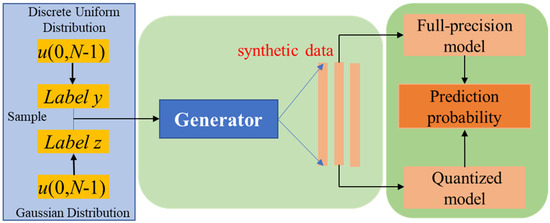
Figure 2.
The basic structure of GANs.
The loss functions and definitions for the generator and discriminator are as follows in Equations (1) and (2):
In the equation, E represents the expectation of a batch of samples, G(z) denotes the data generated from renewable energy sources, z is the noise signal, x represents the historical data of renewable energy output, and D(G(z)) is the probability that the generated data follows the real distribution.
To address the issue of gradient vanishing that often occurs during the training process of GANs, this paper uses the Wasserstein distance to replace the Jensen–Shannon divergence. The definition of the Wasserstein distance is as follows:
In the equation, pdata represents the probability distribution of historical renewable energy output data, pG represents the probability distribution of generated renewable energy output data, sup denotes the supremum (least upper bound), and θd represents the weights in the discriminator. Additionally, to enable the model to converge more quickly, this paper enhances the Lipschitz continuity through the gradient penalty, as expressed in Equation (4):
In the equation, λ is the weight of the penalty term, and ||*||2 denotes the L2 norm.
Conditional GAN (CGAN), as a variant of GAN, introduces additional conditional information into both the generator and the discriminator, aiming to accurately capture the correlation between the generated data and the specific conditions. The generator generates samples according to the given conditional information, while the discriminator, assisted by the conditional information, distinguishes whether a sample is real or generated. The final generated samples can possess the same attributes as training samples with specific label types. Based on inspiration from CGAN, this paper addresses the issue of uncontrollable generated data by using a conditional variable y to guide data generation. The objective function of the conditional generative adversarial network is shown in Equation (5):
Due to the issue of information transmission capacity, it is difficult for convolutional layers to establish long-range dependencies. Increasing the number of network layers to establish long-range dependencies, however, would lead to an increase in training time. The self-attention mechanism is a widely used technique in the field of deep learning. It enables the model to dynamically focus on different parts of the input sequence, allocating different weights based on the relevance between parts, thereby better capturing long-range dependencies between elements in the sequence. Considering the characteristics of renewable energy output, this paper incorporates a self-attention mechanism into the discriminator, allowing the discriminator to readjust the importance weights of each element based on the correlations between input elements, enhancing the model’s subsequent feature extraction and discrimination capabilities. The expressions for self-attention are shown in Equations (6) and (7):
In the equation, W represents the weight coefficient matrix, dk is the scaling factor, softmax is the normalization function, and X is the input sequence.
2.2. Typical Scenario Selection
After Section 2.1, a large number of renewable energy output scenarios are generated. To improve computational efficiency, this paper adopts a typical scenario generation method based on an improved K-means clustering algorithm. By grouping curves with a certain degree of similarity into one category, the number of scenarios is reduced. Compared with the traditional K-medoids clustering algorithms that use Euclidean distance or Manhattan distance to calculate the distance value of cluster centroids, the adoption of Dynamic Time Warping (DTW) distance can not only reflect the distance between selected sequences but also capture the trend changes between them. The specific steps are as follows:
- Use the Monte Carlo simulation to generate annual wind and photovoltaic power generation data and divide these data into m scenarios.
- Randomly divide the data into k categories of scenarios and select one sample from each category as the initial cluster centroid for that scenario.
- Construct a matrix using DTW distance, employ a dynamic programming algorithm to solve for the warping path, and measure the distance between the wind and solar curves to assess the similarity between objects.
- Calculate the new mean for each category of scenarios to form new cluster centroids.
- Repeat the above two steps until the cluster centroids no longer change or the preset maximum number of clustering iterations is reached.
3. Mathematical Model for Power Quality Optimization in Active Distribution Networks
3.1. Objective Function
In this paper, the minimization of node voltage deviation is selected as the objective function, as shown in Equation (8) below.
In the above equation, represents the terminal voltage at node i at time t, represents the rated voltage at node i, and N represents the number of nodes in the system.
3.2. Constraint Conditions
- Power flow equation constraint
In the equation, and represent the injected active and reactive power at node i at time t, respectively; represents the voltage phase angle difference between nodes i and j at time t; represents the voltage magnitude at node j at time t; and and represent the conductance and susceptance of branch ij, respectively.
- 2.
- Node voltage constraint
In the equation, and represent the upper and lower limits of the voltage magnitude at node i, respectively.
- 3.
- OLTC regulation performance constraint
In the equation, represents the single-adjustment step limit for the tap of the OLTC, represents the maximum number of tap adjustments within one scheduling period, and and represent the upper and lower limits of the tap position for the OLTC, respectively.
- 4.
- Constraint on the number of switching groups and regulation capacity of capacitor banks:
In the equation, and represent the upper and lower limits of the number of capacitor bank groups that can be switched on at node i, respectively; and represent the number of CB groups switched on at node i at times t and t + 1, respectively.
- 5.
- Constraint on SVC reactive power output
In the equation, represents the maximum reactive power output of the SVC at node i, and represents the minimum reactive power output of the SVC at node i. In distribution network voltage regulation, SVC demonstrates significant advantages over STATCOM or other FACTS devices in terms of both economic and technical aspects. Utilizing thyristor-controlled reactors (TCRs) or thyristor-switched capacitors (TSCs), SVC features simpler topology with power electronic component costs substantially lower than STATCOM. The mature thyristor technology in SVC requires lower heat dissipation and exhibits lower failure rates, whereas STATCOM’s complex converter circuits demand higher heat dissipation and electromagnetic compatibility standards, increasing maintenance costs. SVC achieves hundreds of MVar-level reactive power compensation in medium-high voltage distribution networks, making it suitable for high-penetration renewable energy integration scenarios. In contrast, STATCOM’s single-unit capacity is typically limited by converter ratings. SVC effectively suppresses harmonic resonance through coordinated control of TCR and fixed capacitors, while STATCOM requires additional filters or complex control strategies to address harmonic interference. SVC enables continuous reactive power compensation through conduction angle adjustment with low control algorithm complexity, whereas STATCOM necessitates high-frequency PWM modulation and vector control, imposing higher demands on controller performance. Furthermore, SVC’s thyristors can withstand 2–3 times rated current momentarily, making them suitable for voltage sags or transient impact loads, while STATCOM’s IGBT modules exhibit weaker overload capacity due to thermal stress limitations. In weak grids or high-impedance lines, SVC achieves voltage stabilization through direct adjustment of equivalent susceptance with minimal system impedance impact. Conversely, STATCOM’s voltage-source characteristics may lead to control instability due to system impedance variations. Therefore, this article chooses SVC for reactive power compensation.
- 6.
- Distributed generation (DG) operation constraint:
In the equation, and represent the active and reactive power outputs of the DG, respectively; and represent the maximum active and reactive power outputs of the DG, respectively. For the sake of generality, this paper adopts a constant power control strategy, where φk represents the power factor angle.
- 7.
- Energy storage device operation constraint
In the equation, and represent the charging and discharging power of the energy storage system, respectively. represents the self-discharge rate of the energy storage. and represent the charging and discharging efficiencies of the energy storage, respectively. and are Boolean variables representing the charging and discharging states of the energy storage, respectively. represents the energy storage capacity. and represent the upper limits of the charging and discharging power of the energy storage, respectively. and represent the lower limits of the charging and discharging power of the energy storage, respectively.
4. Solution Method Based on Improved Gray Wolf Optimizer Algorithm
4.1. An Introduction to the Traditional Gray Wolf Optimizer Algorithm
The Gray Wolf Optimizer (GWO) possesses a hierarchical pyramid structure, with ranks from the highest to the lowest being the α wolf, β wolf, δ wolf, and ω wolf. The GWO algorithm simulates the hunting behavior of gray wolves to search for the optimal solution, which includes the following components:
- Encircling the prey
When searching for prey, a gray wolf pack gradually forms a circle around a targeted animal. This behavior is defined by Equations (16) and (17):
In the equation, D represents the distance vector, A and C are behavioral coefficients, t is the current iteration number, XP is the position vector of the prey, X(t) is the position vector of the gray wolf after t iterations, a is the convergence factor, r1 and r2 are random number vectors within the range [0, 1], and tmax is the maximum number of iterations for the population.
- 2.
- Hunting the prey
After encircling the prey, the leading wolves identify and guide the rest of the pack in the hunt. That is, the ω wolves update their positions based on the positions of the α, β, and δ wolves, which can be expressed as Equations (18) and (19):
In the equation, X1, X2, and X3 represent the positional update perturbations for the individual ω wolf by the three leading wolves. Xα(t), Xβ(t), and Xδ(t) are the positions of the α, β, and δ wolves, respectively, at the t-th iteration. A1, A2, and A3 are the behavioral coefficients for the three leading wolves. D1, D2, and D3 are the distance vectors between the three leading wolves and the individual ω wolf. X(t + 1) is the final position of the ω wolf under the leadership of the α, β, and δ wolves.
4.2. The Improvement of the Algorithm
The initial population of the standard GWO is generated randomly, resulting in an uneven distribution in the search space and a tendency toward local optima. To ensure that the randomly generated individuals are distributed as evenly as possible throughout the entire space, this paper adopts Tent chaotic mapping for initializing the population, thereby enhancing its ability to distribute evenly across the search space, as shown in Equation (20).
Lens learning, based on the opposite learning strategy, models and solves its inverse problem, which can enhance the robustness of the algorithm. The combination of Tent mapping and the lens learning mechanism is applied to population initialization, as shown in Equation (21).
In the equation, represents the improved solution corresponding to each initial solution . and denote the minimum and maximum values among each set of solution vectors from all the initial solutions. is the corresponding chaotic value. The GWO algorithm exhibits insufficient local search capabilities in high-dimensional space, which can easily lead to premature convergence. The complex problems in high-dimensional space require stronger search capabilities than those provided by traditional GWO algorithms. The improved GWO algorithm improves search efficiency and stability through parameter adaptation and population diversity maintenance strategies. Introducing local search techniques and linear population size reduction techniques can help maintain population diversity. The use of Tent chaotic mapping can generate a more uniform initial population and improve the search ability of the algorithm. Mixing multiple chaotic maps, such as logistic maps and Chebyshev maps, among others, can further enhance population diversity and avoid premature convergence. Although a single Tent mapping can improve the initial population uniformity, it is prone to periodic short loops in high-dimensional space iterations. Tests on various chaotic maps, such as Logistic and Chebyshev, have shown that the traversal uniformity of a single map in a space of over 50 dimensions decreases by more than 40%. Reverse learning enhances exploration ability by generating the reverse solution of the current solution. Opposite learning adjusts the position of gray wolves through nonlinear transformations involving exponential operations and vector dot multiplication. Its time complexity is O(D), and it requires dynamic calculation of attenuation factors, adding approximately O(N) floating-point operations. For high-dimensional problems, the computational complexity of nonlinear transformations increases exponentially with the dimensionality, further exacerbating the computational cost. In high-dimensional objective functions, an increase in decision variables leads to an exponential expansion of the solution space. Reverse learning requires exploring more ineffective areas, and the complexity of nonlinear transformations in shot learning also increases sharply. The evaluation time of complex objective functions may already reach milliseconds or even higher, and the additional operations of reverse learning and shot learning may increase the total computational cost several times. Reverse learning and shot learning enhance GWO performance by enhancing exploration ability and adjusting search direction, but generating and evaluating reverse solutions, nonlinear transformations, and other operations lead to a significant increase in computational complexity in high-dimensional or complex objective functions. This cost increase is mainly due to the dimensionality dependency of the inverse solution, the complexity of objective function evaluations, and the computational overhead of nonlinear transformations.
Furthermore, since the convergence factor in the GWO algorithm decreases linearly with the increase in the number of iterations, it struggles to balance global and local search capabilities in the later stages of the algorithm, potentially leading to local optima. In this paper, an exponential function is introduced to improve the convergence factor, as shown in Equation (22).
In the equation, and represent the initial and final values of a, respectively. The improved convergence factor decreases more slowly, better accommodating global searching and enhancing the algorithm’s local search capability in the later stages of iteration.
On the other hand, inspired by the Spider Monkey Optimization algorithm, individual positions are updated using a combination of information from the global leader and local leaders. In the process of reactive power optimization, it is necessary to conduct an in-depth exploration of factors such as minimizing network losses and identifying nodes with the smallest voltage deviation. Therefore, this paper introduces a linearly decreasing inertia weight ω, which takes a larger value in the early stages of iteration and gradually decreases as the number of iterations increases. This ensures global search capability while enhancing the local search capability in the later stages of the algorithm, thereby avoiding premature convergence to local optima in the early stages and preventing the algorithm from escaping from local optima in the later stages. The update of the wolf pack’s positions is based on Equation (23).
In the equation, and represent the initial and final values of the inertia weight, respectively. denotes the global best position of the gray wolves.
5. Case Study
5.1. An Introduction to the Test System
In this paper, an improved IEEE-33 node system is used for case study validation. The topology of the improved IEEE-33 node test system is shown in Figure 3 below. In this system, the wind farm and photovoltaic power plant are connected through nodes 24 and 21, respectively, while the energy storage station and SVC are connected through nodes 17 and 10, respectively. The actual renewable energy output data are shown in Figure 4.
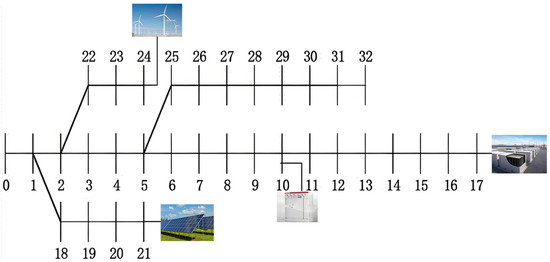
Figure 3.
A topology diagram of the improved IEEE-33 node test system.
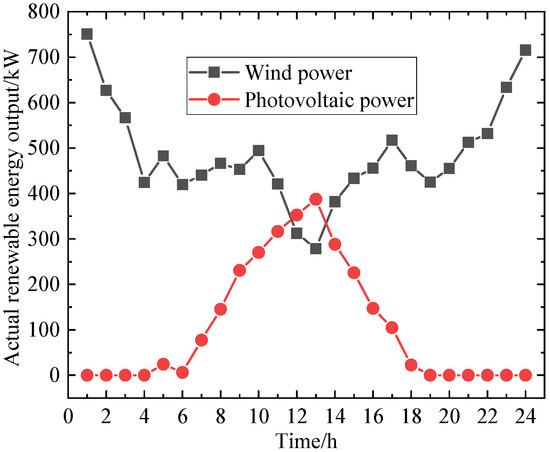
Figure 4.
Actual renewable energy output data.
5.2. Effectiveness Validation of Typical Renewable Energy Output Scenarios
The renewable energy output curves generated and screened using the method proposed in this paper, which constitute typical scenarios, are shown in Figure 5 and Figure 6 below. The number of typical scenarios set in this paper is four.
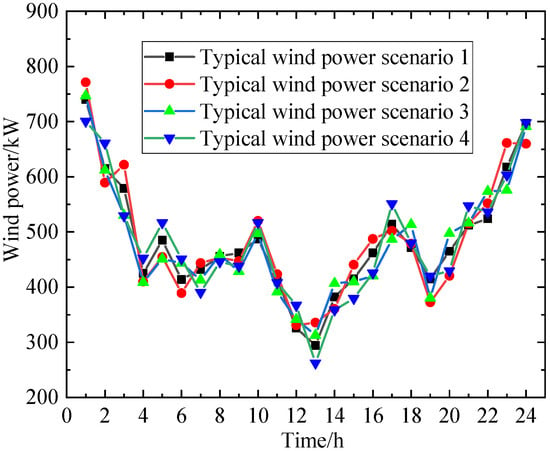
Figure 5.
Typical wind power scenarios generated by the proposed method.
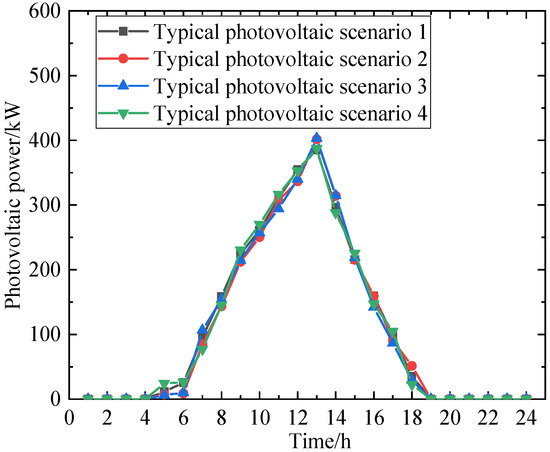
Figure 6.
Typical photovoltaic scenarios generated by the proposed method.
Observing the above figures, the typical wind and solar scenarios generated by the improved CGAN method proposed in this paper are relatively concentrated, with smaller errors. The self-attention mechanism has the ability to capture the relationships between different positions in the input sequence, thereby enabling it to consider global information. In the context of CGAN, this means that the generator can more comprehensively understand the characteristics and distribution of the entire renewable energy output scenario, leading to the generation of more accurate and realistic data. Renewable energy output scenarios often contain complex long-range dependencies, such as changes in output at different time points and differences in output across different geographical locations. The self-attention mechanism effectively handles these long-range dependencies by computing attention weights globally, thereby generating more coherent and consistent output scenarios. The introduction of the self-attention mechanism increases the model complexity of CGAN, enabling it to learn more complex patterns and features. Additionally, the computation process of the self-attention mechanism is interpretable, as the attention weights for each position can be visualized. This aids researchers in targeted optimization and adjustment, further improving generation accuracy and realism. By better capturing global information and long-range dependencies, CGAN can learn the data distribution characteristics more quickly, thereby accelerating the training process and improving generation efficiency. Furthermore, the mean absolute percentage error (MAPE) and Wasserstein distance indicators are adopted for comparison. The detailed results are given in Table 1.

Table 1.
Comparison of indicators for generating different scenarios.
It can be observed from Table 1 that the MAPE indicator and Wasserstein distance indicator of the typical scenarios generated by the method proposed in this article are both the smallest. GCAN transforms the generation process from unsupervised random sampling to controllable constraint generation by introducing conditional variables and physical constraints. This improvement can effectively reduce distribution bias. The scenarios generated by traditional GAN may deviate from actual physical laws, while GCAN ensures that the generated scenarios conform to the characteristics of new energy output through conditional constraints. Physical constraints directly limit the reasonable range of generated values, thereby reducing the MAPE between the predicted and actual values. Traditional GAN is prone to generating duplicate or low-quality samples, while GCAN improves by making the generated distribution closer to the true distribution, thus performing better in global statistical properties. In contrast, Monte Carlo simulation relies on preset probability distributions such as normal distribution assumptions and parameter estimates, making it difficult to capture complex patterns. The output of new energy is affected by multivariate coupling, and preset distributions cannot describe nonlinear relationships. The scene generated by Monte Carlo simulation differs significantly from the real distribution, and the local prediction error is relatively high due to neglecting spatiotemporal correlation.
5.3. Feasibility Verification of Scheduling Model
In this paper, a coordinated optimization of static and dynamic reactive power devices is conducted to achieve efficient voltage regulation. When compared with conventional methods that rely solely on static reactive power devices, the switching positions of the OLTC and the number of capacitor banks switched are shown in Figure 7 and Figure 8 below, respectively.
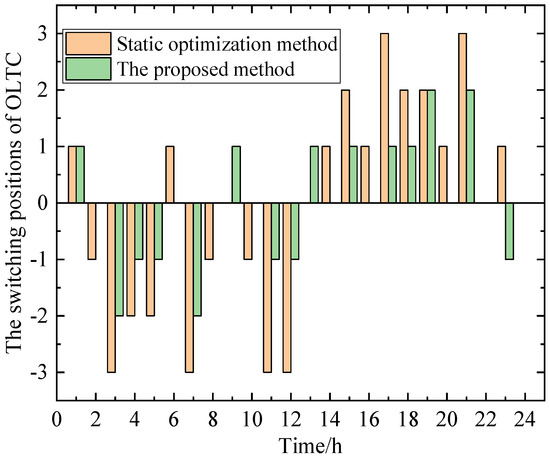
Figure 7.
The switching positions of OLTC.
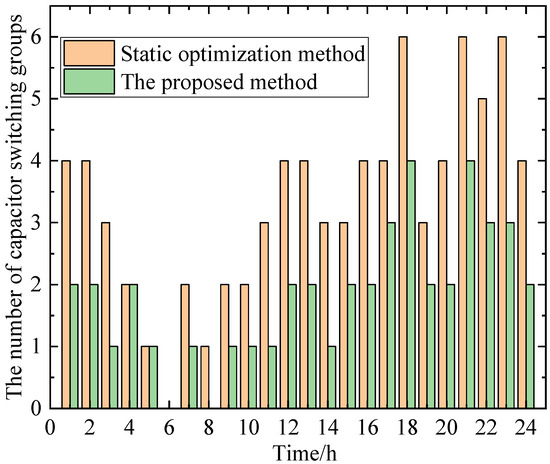
Figure 8.
The number of capacitor switching groups.
By observing Figure 7 and Figure 8, it is not difficult to find that under the method proposed in this paper, there is a significant reduction in both the number of OLTC switching operations and the number of capacitor banks switched. In this paper, voltage regulation is achieved through the coordinated operation of SVC and static reactive power devices. SVC can dynamically compensate for reactive power with a very fast response speed, allowing it to promptly track and compensate for changes in reactive power. In contrast, although traditional capacitor banks can provide fixed reactive power compensation, their response speed is slower, and they cannot track real-time changes in reactive power. SVC can continuously adjust the reactive power of the compensation device by regulating the trigger delay angle of its internal thyristors, thereby achieving more precise control. Capacitor banks, however, can only provide a fixed amount of reactive power compensation and cannot be continuously adjusted based on actual demand. SVC excels in its voltage regulation capability, providing instantaneous reactive power compensation to support voltage and inhibit the tendency of voltage collapse during system faults or sudden increases in load current. Capacitor banks are relatively weaker in this regard. SVC offers advantages such as good regulation performance and low operational losses. Although the initial investment in SVC may be higher, due to its low operational losses, significant savings in electricity bills and maintenance costs can be achieved in the long run. Capacitor banks, while lower in cost, have higher operational losses and require regular maintenance and replacement. SVC is prone to generating harmonic currents, but these can be filtered out with supporting filter banks. Capacitor banks, on the other hand, may suffer from over-compensation or under-compensation due to harmonic issues, affecting the safety and stability of the system.
On the other hand, SVC can dynamically compensate for reactive power based on the actual demand of the system, while OLTC mainly changes the voltage level by adjusting transformer taps, thereby indirectly affecting the distribution of reactive power. SVC is more flexible and precise in terms of reactive power compensation. The response speed of SVC is much faster than that of OLTC. SVC can respond to changes in reactive power and provide compensation within milliseconds, while OLTC takes longer to complete tap adjustments. SVC can enhance the stability and transmission capacity of the power transmission system, stabilizing the receiving end and grid voltage. Although OLTC can improve system stability by adjusting voltage, its effect is relatively limited.
In the distribution network, the standard for optimizing voltage is to ensure the quality of the power supply, the safe operation of the equipment, and economic efficiency. In this paper, the standard for optimizing voltage curves is mainly based on the national standard (GB/T 12325) [33], and the voltage deviation is usually controlled within ±5% to ±10% of the rated voltage. For this article, the voltage was allowed to fluctuate between 0.95 p.u. and 1.05 p.u., but for some extreme scenarios, such as heavy loads or large fluctuations in new energy output, there is no feasible solution for scheduling decisions, and in this case, the hard voltage constraint can only be relaxed. Although a feasible solution can be found at this point, the voltage waveform curve exceeds the safe operating range, as shown in Figure 9. By observing Figure 9 and Figure 10, it can be seen that during periods of high renewable energy output or heavy load, the voltage tends to exceed safe limits. Renewable energy generation, especially from wind and solar sources, is inherently volatile. When renewable energy output is high, if the power grid cannot adjust in a timely manner to balance this fluctuation, it may lead to localized grid voltage increases. In scenarios where renewable energy is integrated into the grid on a large scale, the grid needs to possess stronger dispatch and voltage regulation capabilities. However, if the grid’s dispatch system or voltage regulation equipment (such as OLTC and capacitor banks) lacks sufficient capacity or response speed, it may not effectively address the voltage variations caused by renewable energy output fluctuations. After renewable energy generation is connected to the grid, the fluctuation of its output power will directly affect the stability of the grid voltage. Especially when the proportion of renewable energy generation gradually increases, its impact on grid voltage becomes more significant. When the load increases, the current also increases. Current flowing through line impedance causes a voltage drop, resulting in a decrease in voltage at the load end. This voltage drop phenomenon is more pronounced in cases of long-distance power transmission or high line impedance. If the power source’s capacity is insufficient to meet the demand in heavy load scenarios, its output voltage may decrease. This is because when the power source operates at full or overload capacity, the stability of its output voltage is affected. Reactive power is crucial for maintaining the stability of grid voltage. In heavy load scenarios, if the reactive power supply is insufficient, it may lead to a decrease in grid voltage. This is usually due to the insufficient capacity or response speed of reactive power compensation equipment. The structure and layout of the grid also affect voltage stability. In heavy load scenarios, an unreasonable grid structure or improper layout may result in excessively low voltage in localized grids.
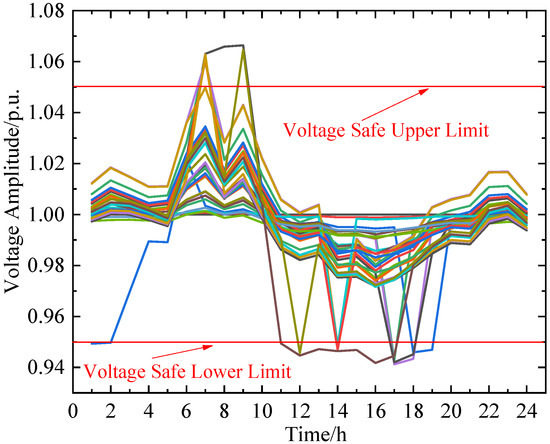
Figure 9.
Voltage curve before optimization.
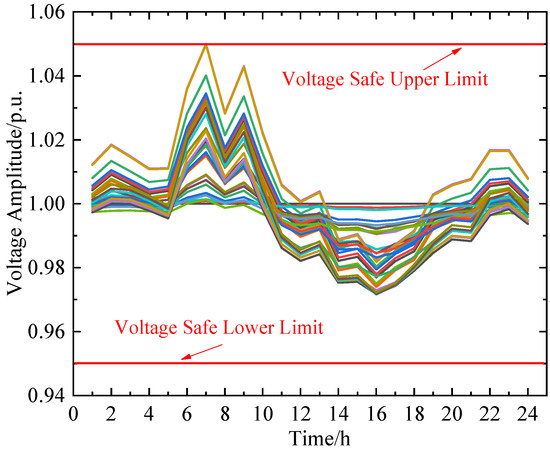
Figure 10.
Voltage curve after optimization.
SVC can quickly respond to changes in reactive power demand caused by load variations or grid faults. When the load suddenly increases, SVC can rapidly absorb reactive power to prevent the voltage from dropping; when the load decreases, SVC can inject reactive power to prevent the voltage from rising. This rapid response capability helps maintain voltage within a preset range. SVC can precisely control the amount of reactive power injected or absorbed by adjusting its internal components such as TCR and TSC. This allows SVC to dynamically regulate reactive power balance based on the actual demand of the grid, thereby suppressing voltage fluctuations. In cases of sudden load changes or grid faults, SVC can reduce the amplitude and duration of voltage fluctuations and increase system damping by adjusting reactive power. This helps stabilize grid voltage and prevent voltage collapse or oscillation. SVC is usually equipped with filters internally to reduce the generation of harmonic currents and harmonic voltages. This helps reduce voltage distortion and improve power supply quality. The application of SVC in power systems yields significant results. It can improve the stability, transmission capacity, and efficiency of power systems, reducing line losses and equipment failure rates. At the same time, SVC can extend the service life of power equipment and improve customer satisfaction. In scenarios in which renewable energy generation is integrated into the grid on a large scale, SVC has become an important device for ensuring grid voltage stability.
6. Discussion on the Application of Large-Scale Testing Systems
In order to further verify the feasibility of the proposed method in large-scale testing systems, this paper uses the IEEE-69 node system for analysis and comparison. Its structural topology is shown in Figure 11. In detail, two wind farms are installed at nodes 40, 57, and 68, respectively. A photovoltaic power station is installed at node 18, energy storage equipment is installed at nodes 32 and 52, and SVC is installed at node 65. Table 2 shows a comparison of scenario generation metrics under the large-scale testing system.
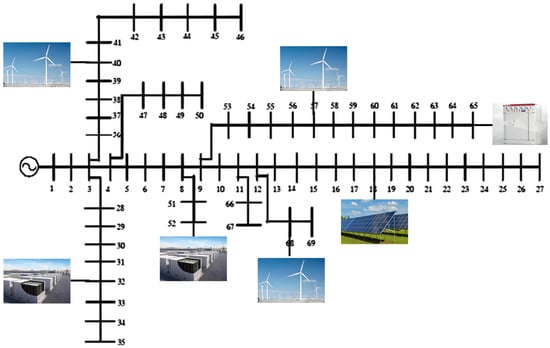
Figure 11.
The topology of the modified IEEE-69 node test system.

Table 2.
Comparison of indicators in modified IEEE-69 node test system.
As shown in Table 2 above, after introducing the self-attention mechanism, the typical scene errors generated by the method proposed in this paper are smaller. The output of new energy has significant spatiotemporal coupling characteristics, specifically the nonlinear relationship between photovoltaic output and sunshine intensity and temperature and the correlation between wind power and pressure gradient and terrain height. The convolutional layers of traditional GANs are limited by local receptive fields, making it difficult to capture global dependencies across time periods. The self-attention mechanism dynamically captures the output changes at key time points by calculating the attention weights at any two moments in the sequence, making the generated scene more in line with real physical laws. The improved CGAN significantly improves the matching degree between the generated scene and the real distribution by constraining the generation process with conditional variables and combining the global feature fusion ability of self-attention. Traditional GANs are prone to pattern collapse, leading to a singularity of the generated scene. However, self-attention strengthens global feature correlation, making the generated distribution closer to the complex multimodal distribution of real data. By dynamically focusing on key features, local prediction errors are significantly reduced. In terms of computational efficiency, the matrix operation characteristics of self-attention are deeply coupled with GPU architecture. When generating large-scale time series, the computational efficiency is significantly higher than that of traditional recurrent neural networks or convolutional networks. Monte Carlo simulation requires iterative sampling at each moment, and the computational complexity increases linearly with the length of the sequence. CGAN can be improved by generating complete sequences through single forward propagation, supporting real-time or quasi-real-time scene generation, and adapting to high timeliness scenarios such as power grid scheduling.
Meanwhile, Table 3 presents a comparison of computational efficiency and optimal results under different solving strategies.

Table 3.
Comparison of indicators in modified IEEE-33 and -69 node test systems.
It can be observed from the table above that the algorithm proposed in this article significantly reduces voltage fluctuations and network losses. And as the system scale expands, the advantages of the method proposed in this article become more apparent. The convergence factor of traditional GWO decreases linearly, which can easily lead to insufficient exploration in the early stage or excessive local development in the later stage. The improved algorithm significantly enhances its global search capability through the nonlinear convergence factor. The calculation results show that the improved algorithm can improve the convergence speed by up to 38.9% on the standard test function and has higher accuracy. The improved GWO algorithm achieves triple optimization of voltage fluctuation rate, network loss, and computation time by enhancing global search capability and convergence speed, combining dynamic reactive power resource collaborative optimization and GCAN scenario compression technology. This method provides an efficient and real-time voltage control solution for distribution networks containing a high proportion of renewable energy.
A sensitivity analysis of the algorithm was conducted to verify the robustness and feasibility of the method in time-varying complex environments. The values of and in the exponential reduction algorithm influence the convergence speed and accuracy. A larger value of facilitates global search, while a smaller value of enhances local search. The chaotic value in the chaotic Gray Wolf Optimization algorithm affects the local search capability, and an appropriate chaotic value can improve the algorithm’s ability to escape local optima. The inertia weight ω influences the balance between global and local searches. A linearly decreasing inertia weight can enhance global search capability in the early stages and local search capability in the later stages. The inertia weight ω adopts a linear decreasing strategy, with the initial value ∈ [0.8, 1.0] and the terminal value ∈ [0.3, 0.5]. The convergence factor has an initial value between 1.5 and 2.5. The chaotic mapping parameter is controlled by the Logistic equation within [3.9, 4.0], ensuring complete chaos. When the initial value of ω > 0.9, excessive exploration in the early stages reduces the convergence speed by 27%. When the terminal value of ω < 0.4, the algorithm is prone to falling into local optima in the later stages, resulting in an 18% loss in accuracy. The decreasing rate = 0.96 yields the best overall performance. When > 2.2, the exploration step size is too large, causing oscillations. When < 1.8, the convergence speed decreases by 40%. When the chaotic value is 3.92, the chaotic sequence is uniformly distributed, increasing the probability of escaping local optima by 33%. When the chaotic value is larger than 4, the periodicity of the sequence increases, degrading the optimization effect. In the IEEE-69-node system with a sudden 30% load increase, the improved algorithm restores stability within five iterations, with the voltage fluctuation rate rising only by 0.02 p.u., whereas traditional methods require 12 iterations, with the fluctuation rate rising by 0.05 p.u. In scenarios in which wind/solar penetration increases by 15% to 45%, the improved algorithm maintains an average voltage qualification rate above 98.6%, while traditional algorithms see the qualification rate drop to 95% when penetration exceeds 35%. In practical applications, a parameter adaptive mechanism can be employed, and regular online parameter calibration can be conducted to ensure the algorithm’s stability and optimization performance under different operating conditions.
7. Conclusions
This paper proposes a dynamic reactive power–voltage coordination optimization method with multi-resource coordination for power quality issues in active distribution networks with large-scale renewable energy integration. By utilizing the GCAN network to generate typical wind and solar power output scenarios, a voltage control model for active distribution networks is established with the objective of minimizing voltage fluctuations while fully exploiting the dynamic reactive power regulation resources within the network. In response to the non-convex and nonlinear characteristics of the model, an improved Gray Wolf Optimizer (GWO) algorithm is adopted for model optimization and solution seeking, effectively addressing power quality issues such as excessive or insufficient voltage magnitudes. The experimental results demonstrate that the proposed method significantly reduces voltage fluctuations and improves power quality on the modified IEEE-33-bus and IEEE-69-bus test systems. Additionally, the method exhibits good adaptability and robustness, capable of meeting voltage control demands under various renewable energy output scenarios.
In the future, as renewable energy generation technology continues to advance and its application scale expands, power quality issues in active distribution networks will become more complex and diverse. Therefore, further research is needed on more advanced power quality control methods and technical means to adapt to the development needs of future power systems. In addition, with the increasing complexity of power grid topology, it is of great importance to establish robust and economically optimal scheduling strategies that consider transient stability constraints.
Author Contributions
Conceptualization, Y.W., Y.G., H.N., P.L., B.C., H.Z. (Hongwei Zhao) and H.Z. (Hongbo Zou); methodology, Y.W., Y.G., H.N., P.L., B.C., H.Z. (Hongwei Zhao) and H.Z. (Hongbo Zou); software, Y.W., Y.G., H.N., P.L., B.C., H.Z. (Hongwei Zhao) and H.Z. (Hongbo Zou); writing—original draft preparation, Y.W., Y.G., H.N., P.L., B.C., H.Z. (Hongwei Zhao) and H.Z. (Hongbo Zou). All authors have read and agreed to the published version of the manuscript.
Funding
This research is funded by the Science and Technology Program of Inner Mongolia (Group) Limited Liability Company (No. 2022-10).
Data Availability Statement
The original contributions presented in this study are included in the article. Further inquiries can be directed to the corresponding author.
Conflicts of Interest
Authors Yongsheng Wang, Yaxuan Guo, Haibo Ning, Peng Li were employed by the company Inner Mongolia Electric Power (Group) Co., Ltd. Ulanqab Power Supply Branch. Authors Baoyi Cen, Hongwei Zhao were employed by the company Shenzhen Zhongdian Electric Power Technology Co., Ltd. The remaining authors declare that the research was conducted in the absence of any commercial or financial relationships that could be construed as a potential conflict of interest.
References
- Tong, H.; Zeng, X.; Yu, K.; Zhou, Z. A Fault Identification Method for Animal Electric Shocks Considering Unstable Contact Situations in Low-Voltage Distribution Grids. IEEE Trans. Ind. Inform. 2025. [Google Scholar] [CrossRef]
- Xia, Y.; Li, Z.; Xi, Y.; Wu, G.; Peng, W.; Mu, L. Accurate Fault Location Method for Multiple Faults in Transmission Networks Using Travelling Waves. IEEE Trans. Ind. Inform. 2024, 20, 8717–8728. [Google Scholar] [CrossRef]
- Li, Z.; Su, S.; Jin, X.; Xia, M.; Chen, Q.; Yamashita, K. Stochastic and Distributed Optimal Energy Management of Active Distribution Networks Within Integrated Office Buildings. CSEE J. Power Energy Syst. 2024, 10, 504–517. [Google Scholar]
- Wu, Z.; Li, G.; Zhang, X.; Zheng, S.; Zhou, S. Analysis and Application of Static Voltage Stability Indices for Distribution Networks Based on Single-Port Coupling Equivalence. Autom. Electr. Power Syst. 2023, 47, 44–54. [Google Scholar]
- Zhang, Q.; Liao, Q.; Tang, F.; Xu, J.; Liu, D.; Zou, H. Static Voltage Stability Assessment Method for Distribution Networks with Distributed Generation Integration. Autom. Electr. Power Syst. 2015, 39, 42–48. [Google Scholar]
- Yang, X.; Lv, L.; Xiang, Y.; Liu, Y.; Liu, F. Coupled “Vehicle-Road-Grid” and the Impact of Worst-Case EV Charging Scenarios on Voltage Stability of Urban Distribution Networks. Electr. Power Autom. Equip. 2019, 39, 102–108+122. [Google Scholar]
- Hu, L.; Liu, K.; Sheng, W.; Meng, X. Fast Probabilistic Assessment Method for Static Voltage Stability of Distribution Networks with Random Output Distributed Generations. Power Syst. Technol. 2014, 38, 2766–2771. [Google Scholar]
- Lu, R.; Qin, W.; Cheng, X.; Zheng, H.; Duan, G.; Tian, L. Static Voltage Stability Assessment Considering Harmonic Impact. High Volt. Eng. 2019, 45, 3635–3644. [Google Scholar]
- Hasan, S.; Agarwal, V. A Voltage Support Scheme for Distributed Generation with Minimal Phase Current Under Asymmetrical Grid Faults. IEEE Trans. Ind. Electron. 2023, 70, 10261–10270. [Google Scholar] [CrossRef]
- Shabestary, M.M.; Mohamed YA, R.I. Asymmetrical Ride-Through and Grid Support in Converter-Interfaced DG Units Under Unbalanced Conditions. IEEE Trans. Ind. Electron. 2019, 66, 1130–1141. [Google Scholar] [CrossRef]
- Zhang, Y.; Zhang, S.; Li, C. Voltage Sag Assessment of Large Power Grids Based on Branch Change Impact Domain. Power Syst. Technol. 2023, 47, 4056–4070. [Google Scholar]
- Huang, J.; Zhang, Y.; Chen, J.; Gao, X.; Jia, R.; Wu, Y. Voltage Sag Assessment of Large Power Grids Based on Multi-Agent System. Power Syst. Prot. Control 2023, 51, 45–53. [Google Scholar]
- Zhao, Y.; Zhang, G.; Hu, W.; Huang, Q.; Chen, Z.; Blaabjerg, F. Meta-Learning Based Voltage Control for Renewable Energy Integrated Active Distribution Network Against Topology Change. IEEE Trans. Power Syst. 2023, 38, 5937–5940. [Google Scholar] [CrossRef]
- Xiao, C.; Zhao, B.; Zhou, J.; Li, P.; Ding, M. Voltage Control for High-Proportion Distributed Photovoltaic Clusters in Distribution Networks Based on Network Partitioning. Autom. Electr. Power Syst. 2017, 41, 147–155. [Google Scholar]
- Chai, Y.; Liu, Y.; Wang, C.; Guo, L.; Zhao, Z.; Gao, S. Coordinated Voltage Control for Distributed Photovoltaic Power Generation Clusters with Incomplete Measurements. Proc. CSEE 2019, 39, 2202–2212. [Google Scholar]
- Cao, D.; Zhao, J.B.; Hu, W.H.; Ding, F.; Huang, Q.; Chen, Z.; Blaabjerg, F. Data-Driven Multi-Agent Deep Reinforcement Learning for Decentralized Voltage Control in Distribution Systems with High Penetration of PVs. IEEE Trans. Smart Grid 2021, 12, 4137–4150. [Google Scholar] [CrossRef]
- Gao, Y.Q.; Wang, W.; Yu, N.P. Consensus Multi-Agent Reinforcement Learning for Volt-VAR Control in Power Distribution Networks. IEEE Trans. Smart Grid 2021, 12, 3594–3604. [Google Scholar] [CrossRef]
- Jiao, W.S.; Chen, J.; Wu, Q.W.; Li, C.; Zhou, B.; Huang, S. Distributed Coordinated Voltage Control for Distribution Networks with DG and OLTC Based on MPC and Gradient Projection. IEEE Trans. Power Syst. 2022, 37, 680–690. [Google Scholar] [CrossRef]
- Shi, M.; Yin, R.; Jiang, W.; Wang, Y.; Hu, P.; Hu, X. Overview of Flexible Grid Connection and Cluster Control Technologies for Distributed Photovoltaics. Electr. Meas. Instrum. 2021, 58, 1–9. [Google Scholar]
- Wei, J.; Wu, Q.W.; Li, C.B.; Huang, S.; Zhou, B.; Chen, D. Hierarchical Event-Triggered MPC-Based Coordinated Control for HVRT and Voltage Restoration of Large-Scale Wind Farm. IEEE Trans. Sustain. Energy 2022, 13, 1819–1829. [Google Scholar] [CrossRef]
- Sun, H.; Xu, T.; Guo, Q.; Li, Y.; Lin, W.; Yi, J.; Li, W. Analysis of the “8.9” Blackout in the UK and Its Implications for China’s Power Grid. Proc. CSEE 2019, 39, 6183–6192. [Google Scholar]
- Zeng, F.; Zhang, J. Spatial-Temporal Characteristics and Analysis Methods of Power System Inertia. Proc. CSEE 2020, 40, 50–58. [Google Scholar]
- Fan, C.; Yao, J.; Zhang, Q.; Xu, C.; Ren, H.; Dou, R. Analysis and Reflection on Oscillation Events in the “8.9” Blackout in the UK. Electr. Power Eng. Technol. 2020, 39, 34–41. [Google Scholar]
- Lin, X.; Wen, Y.; Yang, W. Inertia Security Region: Concept, Characteristics, and Assessment Methods. Proc. CSEE 2021, 41, 3065–3078. [Google Scholar]
- Wen, Y.; Ye, X. Enhancing Frequency Stability of Asynchronous Grids Interconnected with HVDC Links. IEEE Trans. Power Syst. 2018, 33, 1800–1810. [Google Scholar] [CrossRef]
- Xue, L.; Niu, T.; Ge, H.; Zhang, J.; Xue, Y.; Fang, S.; Chen, G.; Wang, Z. A Joint Distributed Optimization Framework for Voltage Control and Emergency Energy Storage Vehicle Scheduling in Community Distribution Networks. IEEE Trans. Ind. Appl. 2024, 60, 5317–5330. [Google Scholar] [CrossRef]
- Mahdavi, M.; Schmitt, K.E.K.; Chamana, M.; Bayne, S. Evaluation of Voltage Fluctuations Effect on Reconfiguration of Distribution Systems. IEEE Syst. J. 2024, 18, 198–209. [Google Scholar] [CrossRef]
- Wang, Z.; Zeng, X.; Li, Z.; Yu, K.; Wu, C.; Jiang, Z.; Zhuo, C. An Active Voltage-Type Grounding Fault Protection Method for Medium-Voltage Distribution Networks with Neutral Point Voltage Flexible Regulation. IEEE Trans. Power Deliv. 2024, 39, 1538–1548. [Google Scholar] [CrossRef]
- Liu, L.; Shi, N.; Wang, D.; Ma, Z.; Wang, Z.; Reno, M.J.; Azzolini, J.A. Voltage Calculations in Secondary Distribution Networks via Physics-Inspired Neural Network Using Smart Meter Data. IEEE Trans. Smart Grid 2024, 15, 5205–5218. [Google Scholar] [CrossRef]
- Xue, L.; Niu, T.; Li, Z.; Li, F. Fast Var Margin Evaluation of High Wind Penetration Power Systems: An Objective-Oriented Dimensionality Reduction Approximation Approach. IEEE Trans. Sustain. Energy 2022, 13, 1722–1733. [Google Scholar] [CrossRef]
- Azad, S.; Ameli, M.T.; Amiri, M.M.; Ameli, H.; Shadi, M.R.; Strbac, G. Real-Time Voltage Stability Assessment with a Novel Bus Index Considering Impact of Connection to Distribution Networks. IEEE Access 2025, 13, 4683–4696. [Google Scholar] [CrossRef]
- Cho, Y.-H.; Liu, S.; Zhu, H.; Lee, D. Wind Power Scenario Generation Using Graph Convolutional Generative Adversarial Network. In Proceedings of the 2023 IEEE Power & Energy Society General Meeting (PESGM), Orlando, FL, USA, 16–20 July 2023; pp. 1–5. [Google Scholar]
- Available online: https://openstd.samr.gov.cn/bzgk/gb/newGbInfo?hcno=75EBBCF838AA40D281EDA854B8F63AD7 (accessed on 8 March 2025).
Disclaimer/Publisher’s Note: The statements, opinions and data contained in all publications are solely those of the individual author(s) and contributor(s) and not of MDPI and/or the editor(s). MDPI and/or the editor(s) disclaim responsibility for any injury to people or property resulting from any ideas, methods, instructions or products referred to in the content. |
© 2025 by the authors. Licensee MDPI, Basel, Switzerland. This article is an open access article distributed under the terms and conditions of the Creative Commons Attribution (CC BY) license (https://creativecommons.org/licenses/by/4.0/).